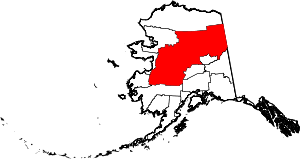Shageluk, Alaska
| Shageluk Łeggi Jitno’ | |
|---|---|
| City | |
 Shageluk Location in Alaska | |
| Coordinates: 62°39′22″N 159°31′52″W / 62.65611°N 159.53111°WCoordinates: 62°39′22″N 159°31′52″W / 62.65611°N 159.53111°W | |
| Country | United States |
| State | Alaska |
| Census Area | Yukon-Koyukuk |
| Incorporated | July 9, 1970[1] |
| Government | |
| • Mayor | Chevie Roach[2] |
| • State senator | Lyman Hoffman (D) |
| • State rep. | Bryce Edgmon (D) |
| Area | |
| • Total | 12.0 sq mi (31.0 km2) |
| • Land | 10.6 sq mi (27.4 km2) |
| • Water | 1.4 sq mi (3.6 km2) |
| Elevation | 62 ft (19 m) |
| Population (2007)[3] | |
| • Total | 116 |
| • Density | 12.2/sq mi (4.7/km2) |
| Time zone | Alaska (AKST) (UTC-9) |
| • Summer (DST) | AKDT (UTC-8) |
| ZIP code | 99665 |
| Area code | 907 |
| FIPS code | 02-68670 |
Shageluk (Łeggi Jitno’[4] in Deg Xinag) is a city in Yukon-Koyukuk Census Area, Alaska, United States. At the 2000 census the population was 129.
Geography
Shageluk is located at 62°39′22″N 159°31′52″W / 62.65611°N 159.53111°W (62.655998, -159.531132).[5]
According to the United States Census Bureau, the city has a total area of 12.0 square miles (31 km2), of which, 10.6 square miles (27 km2) of it is land and 1.4 square miles (3.6 km2) of it (11.53%) is water.
Demographics
| Historical population | |||
|---|---|---|---|
| Census | Pop. | %± | |
| 1920 | 130 | — | |
| 1930 | 88 | −32.3% | |
| 1940 | 92 | 4.5% | |
| 1950 | 100 | 8.7% | |
| 1960 | 155 | 55.0% | |
| 1970 | 167 | 7.7% | |
| 1980 | 131 | −21.6% | |
| 1990 | 139 | 6.1% | |
| 2000 | 129 | −7.2% | |
| 2010 | 83 | −35.7% | |
| Est. 2015 | 83 | [6] | 0.0% |
As of the census[8] of 2000, there were 129 people, 36 households, and 29 families residing in the city. The population density was 12.2 people per square mile (4.7/km²). There were 52 housing units at an average density of 4.9 per square mile (1.9/km²). The racial makeup of the city was 3.10% White and 96.90% Native American.
There were 36 households out of which 44.4% had children under the age of 18 living with them, 33.3% were married couples living together, 33.3% had a female householder with no husband present, and 16.7% were non-families. 16.7% of all households were made up of individuals and none had someone living alone who was 65 years of age or older. The average household size was 3.58 and the average family size was 3.83.
In the city the age distribution of the population shows 42.6% under the age of 18, 7.0% from 18 to 24, 25.6% from 25 to 44, 14.7% from 45 to 64, and 10.1% who were 65 years of age or older. The median age was 26 years. For every 100 females there were 108.1 males. For every 100 females age 18 and over, there were 124.2 males.
The median income for a household in the city was $26,667, and the median income for a family was $24,000. Males had a median income of $11,250 versus $22,083 for females. The per capita income for the city was $7,587. There were 11.8% of families and 16.2% of the population living below the poverty line, including 23.5% of under eighteens and none of those over 64.
See also
References
- ↑ "Directory of Borough and City Officials 1974". Alaska Local Government. Juneau: Alaska Department of Community and Regional Affairs. XIII (2): 75. January 1974.
- ↑ 2015 Alaska Municipal Officials Directory. Juneau: Alaska Municipal League. 2015. p. 145.
- ↑ "Annual Estimates of the Population for Incorporated Places in Alaska". United States Census Bureau. 2008-07-10. Retrieved 2008-07-14.
- ↑ ankn.uaf.edu: Deg Xinag Ałixi Ni’elyoy / Deg Xinag Learners' Dictionary (2007)
- ↑ "US Gazetteer files: 2010, 2000, and 1990". United States Census Bureau. 2011-02-12. Retrieved 2011-04-23.
- ↑ "Annual Estimates of the Resident Population for Incorporated Places: April 1, 2010 to July 1, 2015". Retrieved July 2, 2016.
- ↑ "Census of Population and Housing". Census.gov. Retrieved June 4, 2015.
- ↑ "American FactFinder". United States Census Bureau. Retrieved 2008-01-31.
